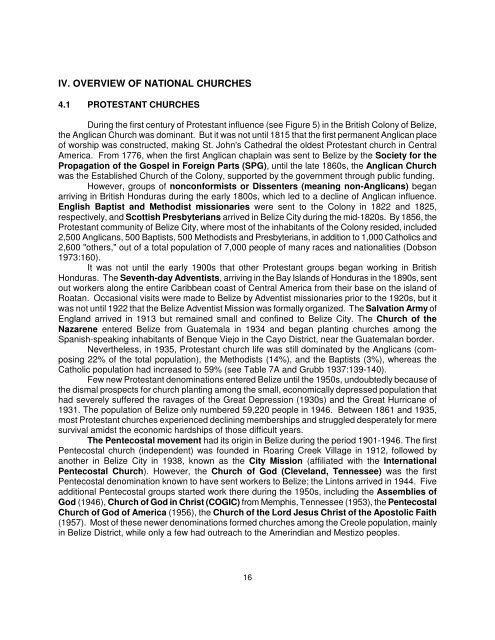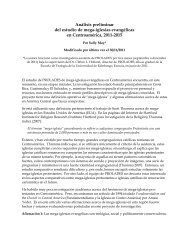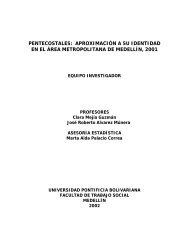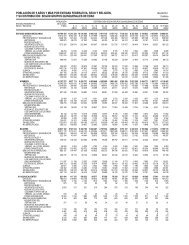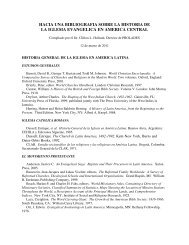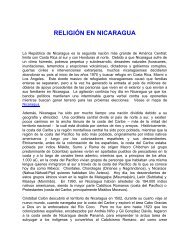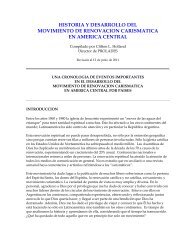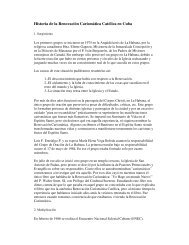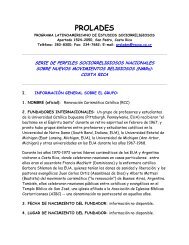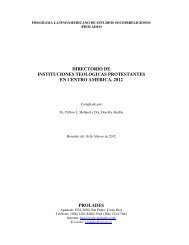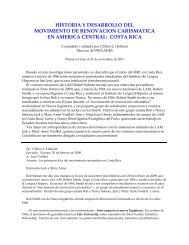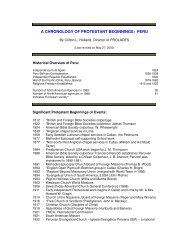belize, 1980 - Prolades.com
belize, 1980 - Prolades.com
belize, 1980 - Prolades.com
You also want an ePaper? Increase the reach of your titles
YUMPU automatically turns print PDFs into web optimized ePapers that Google loves.
IV. OVERVIEW OF NATIONAL CHURCHES<br />
4.1 PROTESTANT CHURCHES<br />
During the first century of Protestant influence (see Figure 5) in the British Colony of Belize,<br />
the Anglican Church was dominant. But it was not until 1815 that the first permanent Anglican place<br />
of worship was constructed, making St. John's Cathedral the oldest Protestant church in Central<br />
America. From 1776, when the first Anglican chaplain was sent to Belize by the Society for the<br />
Propagation of the Gospel in Foreign Parts (SPG), until the late 1860s, the Anglican Church<br />
was the Established Church of the Colony, supported by the government through public funding.<br />
However, groups of nonconformists or Dissenters (meaning non-Anglicans) began<br />
arriving in British Honduras during the early 1800s, which led to a decline of Anglican influence.<br />
English Baptist and Methodist missionaries were sent to the Colony in 1822 and 1825,<br />
respectively, and Scottish Presbyterians arrived in Belize City during the mid-1820s. By 1856, the<br />
Protestant <strong>com</strong>munity of Belize City, where most of the inhabitants of the Colony resided, included<br />
2,500 Anglicans, 500 Baptists, 500 Methodists and Presbyterians, in addition to 1,000 Catholics and<br />
2,600 "others," out of a total population of 7,000 people of many races and nationalities (Dobson<br />
1973:160).<br />
It was not until the early 1900s that other Protestant groups began working in British<br />
Honduras. The Seventh-day Adventists, arriving in the Bay Islands of Honduras in the 1890s, sent<br />
out workers along the entire Caribbean coast of Central America from their base on the island of<br />
Roatan. Occasional visits were made to Belize by Adventist missionaries prior to the 1920s, but it<br />
was not until 1922 that the Belize Adventist Mission was formally organized. The Salvation Army of<br />
England arrived in 1913 but remained small and confined to Belize City. The Church of the<br />
Nazarene entered Belize from Guatemala in 1934 and began planting churches among the<br />
Spanish-speaking inhabitants of Benque Viejo in the Cayo District, near the Guatemalan border.<br />
Nevertheless, in 1935, Protestant church life was still dominated by the Anglicans (<strong>com</strong>posing<br />
22% of the total population), the Methodists (14%), and the Baptists (3%), whereas the<br />
Catholic population had increased to 59% (see Table 7A and Grubb 1937:139-140).<br />
Few new Protestant denominations entered Belize until the 1950s, undoubtedly because of<br />
the dismal prospects for church planting among the small, economically depressed population that<br />
had severely suffered the ravages of the Great Depression (1930s) and the Great Hurricane of<br />
1931. The population of Belize only numbered 59,220 people in 1946. Between 1861 and 1935,<br />
most Protestant churches experienced declining memberships and struggled desperately for mere<br />
survival amidst the economic hardships of those difficult years.<br />
The Pentecostal movement had its origin in Belize during the period 1901-1946. The first<br />
Pentecostal church (independent) was founded in Roaring Creek Village in 1912, followed by<br />
another in Belize City in 1938, known as the City Mission (affiliated with the International<br />
Pentecostal Church). However, the Church of God (Cleveland, Tennessee) was the first<br />
Pentecostal denomination known to have sent workers to Belize; the Lintons arrived in 1944. Five<br />
additional Pentecostal groups started work there during the 1950s, including the Assemblies of<br />
God (1946), Church of God in Christ (COGIC) from Memphis, Tennessee (1953), the Pentecostal<br />
Church of God of America (1956), the Church of the Lord Jesus Christ of the Apostolic Faith<br />
(1957). Most of these newer denominations formed churches among the Creole population, mainly<br />
in Belize District, while only a few had outreach to the Amerindian and Mestizo peoples.<br />
16


